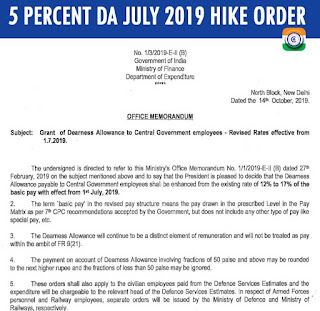Corrected version of Draft of JCM’s Memorandum to be submitted to 7th CPC – Please give your valuable suggestions
The 6th CPC submitted its report in March 2008. It made major changes
in the structure of pay scales by introducing the concept of Pay band
and Grade Pay. Their recommendations were implemented with effect from
1.1.2006. There were plethora of anomalies, common as well as department
specific. None of these anomalies were removed despite several rounds
of discussions.
1.2. On 1.1.2011, the percentage of DA entitlement crossed over 50%. Since the erosion of the value of wages by that time had become enormous, the demand for merger of DA was raised by the employees. Some of them demanded setting up of the 7th CPC on the plea that the residency period of any wage structure must not exceed 5 years, especially in the background that the pay revision in most of the PSUs takes place at the interval of 5 years.They also pointed out that unlike the 5th CPC the 6th CPC had not suggested as to when the next wage revision must be attempted. The Government ignored those demands, despite well knowing that the inflation and abnormal price rise of food and other essential commodities had reduced the purchasing capacity of the government employees significantly.
1.3 Government refused to discuss these demands either bilaterally or at the forum of JCM. A section of the employees went on a day’s strike action, while the industrial workers in the Railways and Defence took the strike ballot. Climate of confrontation emerged. Taking note of these developments, Government in September 2013 announced the setting up of the 7th CPC. The Standing Council of JCM, National Council met on 24th October, 2013 to discuss various issues connected with the finalisation of the terms of reference of the Commission. The following suggestions were made for incorporation in the Terms of Reference (TOR):
The Commission should have a labour representative.
1.5 It will be the endeavour of the Staff Side to bring about commonality of approach on all issues concerning the wages, allowances and other relevant matters, as was the case on the previous occasions. We are hopeful that all the Associations/ Federations/Unions of Central Government employees will endorse this memorandum, prepared by the Staff Side, National Council, JCM on their behalf. No doubt they will submit separate memoranda on department specific issues.
1.6 With this introduction, we submit this memorandum to the 7th CPC for their consideration.
Click here to download JCM’s Memorandum [1.5 MB .pdf]
PREFACE
1.2. On 1.1.2011, the percentage of DA entitlement crossed over 50%. Since the erosion of the value of wages by that time had become enormous, the demand for merger of DA was raised by the employees. Some of them demanded setting up of the 7th CPC on the plea that the residency period of any wage structure must not exceed 5 years, especially in the background that the pay revision in most of the PSUs takes place at the interval of 5 years.They also pointed out that unlike the 5th CPC the 6th CPC had not suggested as to when the next wage revision must be attempted. The Government ignored those demands, despite well knowing that the inflation and abnormal price rise of food and other essential commodities had reduced the purchasing capacity of the government employees significantly.
1.3 Government refused to discuss these demands either bilaterally or at the forum of JCM. A section of the employees went on a day’s strike action, while the industrial workers in the Railways and Defence took the strike ballot. Climate of confrontation emerged. Taking note of these developments, Government in September 2013 announced the setting up of the 7th CPC. The Standing Council of JCM, National Council met on 24th October, 2013 to discuss various issues connected with the finalisation of the terms of reference of the Commission. The following suggestions were made for incorporation in the Terms of Reference (TOR):
The Commission should have a labour representative.
- DA (the extent of percentage as on 1.1.2014) to be merged and treated as pay for all purposes.
- To include Gramin Dak Sewaks within the ambit of 7th CPC.
- To grant Interim Relief @ 25% of Pay + GP.
- To ensure that the 7th CPC recommendation will be effective from 1.1.2014.
- To ensure parity in pension for all pensioners as per the 5th CPC recommendation.
1.5 It will be the endeavour of the Staff Side to bring about commonality of approach on all issues concerning the wages, allowances and other relevant matters, as was the case on the previous occasions. We are hopeful that all the Associations/ Federations/Unions of Central Government employees will endorse this memorandum, prepared by the Staff Side, National Council, JCM on their behalf. No doubt they will submit separate memoranda on department specific issues.
1.6 With this introduction, we submit this memorandum to the 7th CPC for their consideration.
Click here to download JCM’s Memorandum [1.5 MB .pdf]










